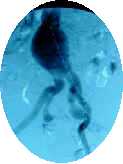- Acute Care
- Cardiothoracic Surgery
- Colon and Rectal Surgery
- General Surgery, MIS, and Bariatric Surgery
- Oral & Maxillofacial Surgery
- Pediatric Surgery
- Plastic & Reconstructive Surgery
- Surgical Oncology
- Transplant
- Urologic Surgery
- Vascular
- Faculty
- Staff
- Patient Care
- Clinical Services
- Vascular Diseases
- Abdominal Aortic Aneurysm (AAA)
- Carotid Artery Disease
- Chronic Venous Insufficiency
- Claudication
- Deep Vein Thrombosis (DVT) / Thrombophlebitis
- Peripheral Arterial Disease (PAD)
- Renal Vascular Disease
- Thoracic Aortic Aneurysm
- Varicose Veins
- Vascular Procedures
- Vascular Studies
- Research
- Employment Opportunities
What is an Abdominal Aortic Aneurysm, or AAA?
Abdominal aortic aneurysms (AAA) are caused by progressive weakening of the aortic wall creating a “ballooning” of the vessel. The aneurysm will grow larger and eventually rupture if it is not diagnosed and treated. Aneurysms occur most often in the aorta, the main artery of the chest and abdomen. The aorta carries blood flow from the heart to all parts of the body including the vital organs and the legs and feet.
What Causes an AAA?
Proteins in the wall of the aorta, called elastin and collagen provide strength and flexibility to this large artery. This is similar to muscles and tendons providing strength to the arms and legs. Aneurysms are caused by a progressive breakdown of these proteins that lead to a weakness of the wall of the aorta that can steadily expand like a balloon. These proteins, collagen and elastin, may gradually deteriorate with age.
Inflammation that is associated with atherosclerosis (hardening of the arteries) helps to accelerate this degenerative process even in younger people. Some of the body’s naturally occurring enzymes may also cause the breakdown of collagen and elastin in the wall of the aorta. An excess of these enzymes or conditions that activate the enzymes may cause the formation of an aneurysm, or lead to its sudden growth. In rare cases an aneurysm may be caused by infection. There is still much to be learned about the cause of aneurysms and their growth at the Vascular Disease Foundation website.
This image of an angiogram shows a typical aortic aneurysm. As the aneurysm gets larger, the risk of rupture increases greatly.

- Acute Care
- Cardiothoracic Surgery
- Colon and Rectal Surgery
- General Surgery, MIS, and Bariatric Surgery
- Oral & Maxillofacial Surgery
- Pediatric Surgery
- Plastic & Reconstructive Surgery
- Surgical Oncology
- Transplant
- Urologic Surgery
- Vascular
- Faculty
- Staff
- Patient Care
- Clinical Services
- Vascular Diseases
- Abdominal Aortic Aneurysm (AAA)
- Carotid Artery Disease
- Chronic Venous Insufficiency
- Claudication
- Deep Vein Thrombosis (DVT) / Thrombophlebitis
- Peripheral Arterial Disease (PAD)
- Renal Vascular Disease
- Thoracic Aortic Aneurysm
- Varicose Veins
- Vascular Procedures
- Vascular Studies
- Research
- Employment Opportunities

